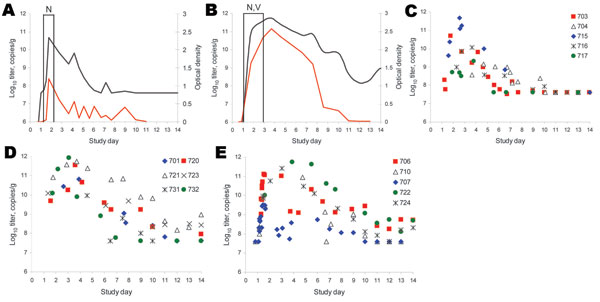Volume 14, Number 10—October 2008
Research
Norwalk Virus Shedding after Experimental Human Infection
Figure 1

Figure 1. Shedding of Norwalk virus in feces. The quantity of viral RNA measured by quantitative reverse transcription–PCR (qRT-PCR; black line) and of virus antigen measured by ELISA (optical density; blue line) is shown for 2 participants: no. 703, who did not have clinical gastroenteritis (panel A), and no. 721, who had clinical gastroenteritis (panel B). Vertical lines represent the period of clinical symptoms; N, nausea; V, vomiting. Panels C, D, and E show the virus titers as measured by qRT-PCR in fecal samples collected from participants who had no clinical gastroenteritis, had gastroenteritis with vomiting only, and had gastroenteritis with vomiting and diarrhea, respectively.
Page created: July 13, 2010
Page updated: July 13, 2010
Page reviewed: July 13, 2010
The conclusions, findings, and opinions expressed by authors contributing to this journal do not necessarily reflect the official position of the U.S. Department of Health and Human Services, the Public Health Service, the Centers for Disease Control and Prevention, or the authors' affiliated institutions. Use of trade names is for identification only and does not imply endorsement by any of the groups named above.